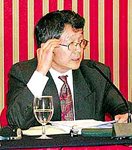 “Feudalism is the main source of Nepal’s problems.” The nepalnews.com headline was unremarkable in its uniqueness. A split-second later, after the customary colon, the attribution raised the news value several notches.
“Feudalism is the main source of Nepal’s problems.” The nepalnews.com headline was unremarkable in its uniqueness. A split-second later, after the customary colon, the attribution raised the news value several notches.No, this wasn’t a leader of one of the assortment of communist splinter groups defying King Gyanendra through some bold ideological affirmation. Nor was it a rant from a newly embittered ex-constitutional monarchist from one of the Nepali Congress factions.
The declaration came from Kenichi Ohashi, country director of the World Bank, in a speech to the Management Association for Nepal.
Emanating from a citizen of another Asian monarchy, one’s interest was instantly aroused. Feudalism in Nepal, after all, has long been a pejorative attached to the king.
Considering the lengths to which Ohashi had gone a couple of years ago to defend the palace-appointed government’s decision to raise fuel prices, the statement triggered additional curiosity. One recalls how irate students and activists criticized Ohashi’s overstepping of diplomatic protocol. Since he rode a blue-plated car, he was automatically expected to maintain the deference of, say, the Japanese ambassador of the day. (One good reason for the government not to be so liberal in issuing CD plates.)
The mind then wandered a few months further back. The World Bank’s vice-president for South Asia, Mieko Nishimizu, criticized the massive corruption and waste inflicted on Nepal by successive governments (when Sher Bahadur Deuba was still the elected prime minister, to be precise). A leading poet penned stanzas eulogizing the lady – yes, a Japanese national -- for showing Nepali leaders a mirror to their faces.
With Tokyo having become increasingly vocal in its anxiety over the lack of democracy in Nepal these days, could Ohashi’s remark carry added portents?
A few sentences later, it emerged that the feudalism Ohashi was talking about was far broader than the accepted definition in Nepal. As the prime multilateral lender, the World Bank rep was intent on ensuring that policy makers did not defer development as they struggled to sort out their politics.
Lords And Vassals
Etymologically, “feudalism” was coined in the seventeenth century, based on the Late Latin feudum, which, in turn, was borrowed from Germanic *fehu. That term was commonly used in the Middle Ages for a fief, land held under certain obligations by feodati.
In essence, lords granted land to vassals in exchange for military service. Since land was limited, there came a point when lords could no longer provide more territory to elicit unflinching cooperation from vassals.
Nor could the lords enforce the right to reassign land, which had become de facto hereditary property. As such, feudalism lost its luster as a working relationship.
Over time, economies, hitherto mostly agrarian, transformed into ones based on money. Land ownership still determined wealth and status, but liquid assets carried increasingly greater value. Seeking a way to become independent of nobles, especially for military support, the kings eventually created standing national armies.
In Nepal, cries against feudalism come out prominently during struggles for democracy. This is understandable considering how radicals during the French revolution successfully used the term to denigrate the monarchy. This selective articulation, however, could distort the political discourse in a country where lordship and vassaldom are endemic in different forms.
For Nepal, the more relevant aspect of the history of feudalism is this: The king was a lord who loaned fiefs to aristocrats, who were his vassals. The aristocrats, on the other hand, were lords to their own vassals, the peasants who worked on their land. What Ohashi and the World Bank seem to be getting at is this element of Nepalese society – whether Nepal remains a monarchy or becomes a republic.
During the apogee of multiparty democracy, from 1990 to 2002, Khum Bahadur Khadka of the Nepali Congress always had at least two dozen legislators in his pocket. After creating and destroying successive governments, Khadka almost single-handedly created Sher Bahadur Deuba’s Nepali Congress (Democratic) amid widening rifts in the parent party. The arrangement couldn’t work because Khadka thought – not incorrectly – he was the lord and Deuba the vassal.
Perched at another level were Nepali Congress leader Chiranjibi Wagle and his son Devendra. A proletarian like Maoist ideologue Dr. Baburam Bhattarai could not resist calling Wagle “Khursani Maila,” a pejorative that had come to describe how a hand-to-mouth chilli trader could end up running a vast patronage plant and enriching his family.
If Pushpa Kamal Dahal and Dr. Bhattarai eventually take over Nepal, they will probably face Hamas’ dilemma: moderating themselves enough to continue receiving the international assistance their realm cannot do without.
Ohashi probably wants to make sure a wayward Prakash Dahal and Manasi Bhattarai don’t end up wrecking the People’s Republic of Nepal their fathers have spilled so much blood for.